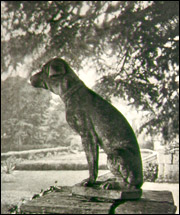| |
In 1650, a rectangular plan castle, which is still apparent in the main courtyard, was built by René le Pelletier. The castle was luxuriously decorated and because of his debts, René le Pelletier had to sell his castle to his son-in-law, Gabriel Constantin.
Vast stables and outbuildings were later added by Gabriel Felix, Gabriel Constantin’s grand son, in order to supply the Royal House. Gabriel Felix who was the Anjou great Provost, was also the Maine , Anjou and Touraine Royal stud farms superintendent.
The castle was then modernized by his son, the marquis of la Lorie Charles-Felix Constantin, in order to host many, often foreign, personalities. Two wings were added on both sides of the original building to install the chapel and the great marble lounge.

Entry of the Castle
The large marble lounge, built in 1780, is exceptional in a private castle since the techniques used were usually dedicated to royal palaces. Drawn by the architect Jean-Sébastien Leysner, this masterpiece is close to the great ‘salon de la Guerre et de la Paix ’ executed the century before in the castle of Versailles . Both were built within identical dimensions. A cleverly decorated dome, designed to collect the impressive lustre’s heat, crowns the ceiling. The pieces of furniture, ordered from the Parisian cabinetmaker Pluvinet in 1779, are still used in the marble room. The dining room, initially built upstairs, was installed around 1779 at the ground floor and the upstairs rooms arranged in bedrooms.

The marchioness of Marmier, eldest girl of the marquis de la Lorie , lived in the chateau until her death in 1842 before her granddaughter, the duchess of Fitz-James, settled there. Her son, the duke of Fitz-James, carries out great life style in la Lorie which the press describes as "quasi royal" castle. Ruined by the game, the duke sold the chateau de la Lorie in 1886 to the marquis de Saint Genys. A Saint-Genys’ descendant still at this time owns the castle.
The chateau have been unceasingly embellished and increased with the wire of the centuries and still is in the beginning of the 20 th century. Added in 1904, the great gallery was built in the 18 th century dining room, by the marquis of Saint Genys in order to host antics and pieces of arts. At the same time, a remarkable round dining room, signed by the Parisian architect Camut, was built and decorated by the marquis with 1730’ Parisian style sculpted woodwork bought at the demolition of the castle of Vitry .
|
|



